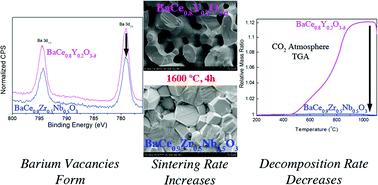Effect of composition and microstructure on electrical properties and CO2 stability of donor-doped, proton conducting BaCe1−(x+y)ZrxNbyO3†
Abstract
Acceptor-doped BaCeO3 perovskites have frequently been studied as high temperature proton conductors (HTPCs) where conduction occurs due to hydroxyl protons that occupy the oxide ion vacancies in the perovskite-type structure. Recently, donor-doped perovskites of the nominal composition BaCe0.7Zr0.2Nb0.1O3 have demonstrated mixed proton–electron conduction in humidified H2 and N2. The proton conduction mechanism is assumed to be similar to that of acceptor-doped perovskites, where the reduction of B-site cations is suggested. In this study, BaCe1−(x+y)ZrxNbyO3 (x = 0.05–0.2, y = 0.05–0.1) are characterized using X-ray photoelectron spectroscopy (XPS), powder X-ray diffraction (PXRD), scanning electron microscopy (SEM), energy-dispersive X-ray spectroscopy (EDS), and AC impedance spectroscopy. The role of composition and sintering temperature on microstructural, chemical, stoichiometric, and electrical properties is thoroughly investigated. PXRD shows the formation of orthorhombic perovskites in all samples and SEM images reveal that a decrease in porosity and increase in grain size are significantly affected by relative Zr and Nb dopant levels. The improved densification caused by the Nb doping leads to enhanced total conductivity by lowering the grain-boundary resistance. Surface analysis by XPS indicates that Ba vacancies in as-prepared BaCe1−(x+y)ZrxNbyO3 can be controlled by composition and temperature control. The co-doping of Nb and Zr lead to enhanced chemical stability in CO2 at elevated temperatures compared to the parent compound. The bulk electrical conductivity decreases with increasing Zr content in BaCe1−(x+y)ZrxNbyO3 in air. Among the samples investigated in this work, BaCe0.9Zr0.05Nb0.05O3 exhibits the highest bulk conductivity of 10−3 S cm−1 at 400 °C with an activation energy of 0.43 eV (400–700 °C).


 Please wait while we load your content...
Please wait while we load your content...